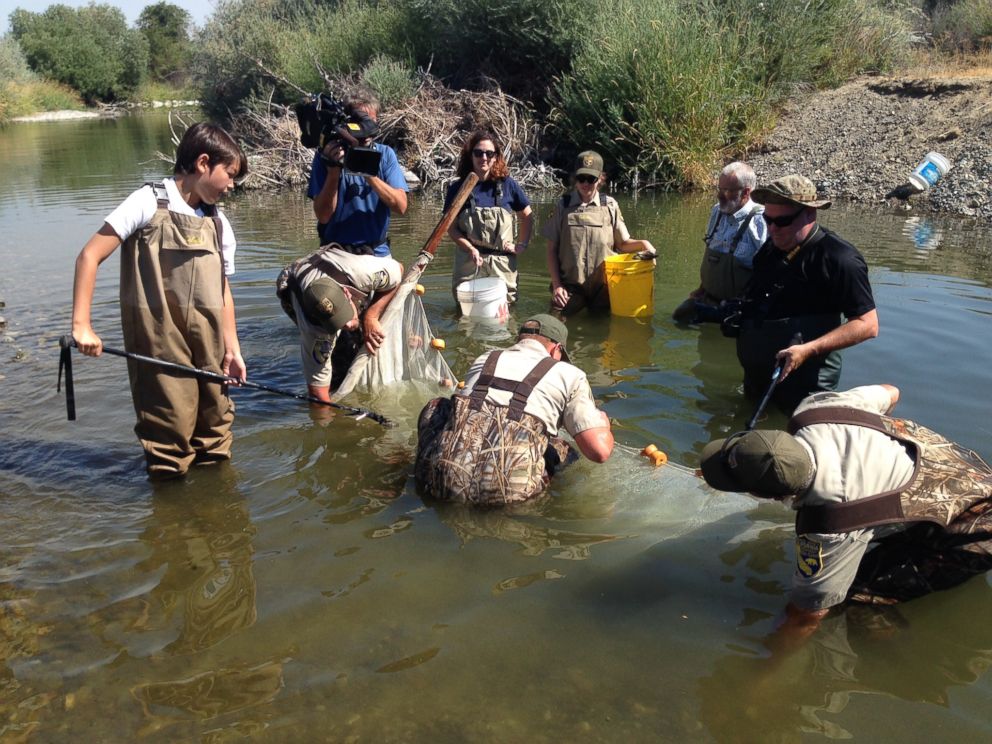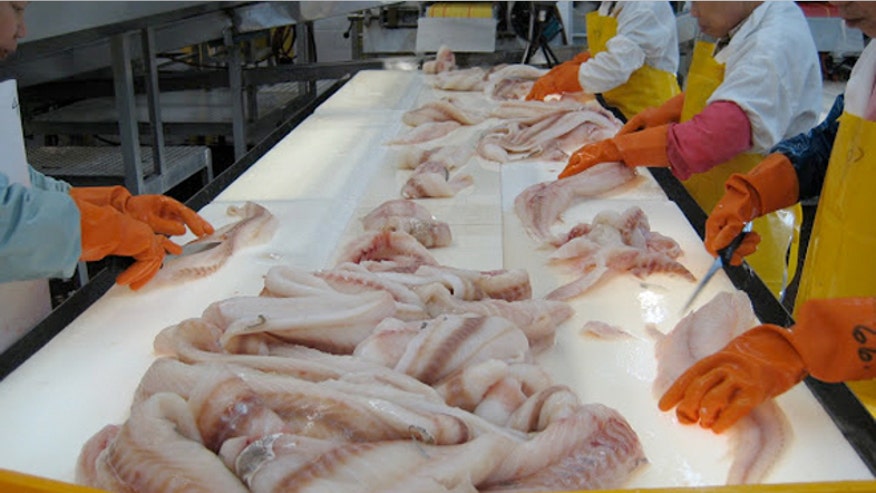|
|
From Peter to Paul: One Fish Kill to Prevent Another
|
|
|
|
September 8, 2014
It's been said that whiskey is for drinking and water is for fighting over. In this third year of one of the worst droughts in California history, these words most certainly ring true. The Klamath and Trinity Rivers in the northwest corner of the state have long histories of bitter water wars. Now, the current water balancing act to help Chinook salmon has lead to a fish kill of Kokanee salmon on the Trinity River's Lewiston Lake, illustrating how one fish species can become collateral damage in the effort to save another.
To prevent another Chinook die-off of this scale happening now, a decision was made at the end of August to increase the current river flow from Lewiston Dam, with the goal to keep the Lower Klamath River at roughly 2,500 cfs until September 14th. This decision comes at a time when Trinity Lake, the reservoir upstream that feeds Lewiston Lake, currently stands at 28 percent capacity. The salmon fishery is an important part of the local economy in communities found along the Trinity and Klamath Rivers, particularly among local tribes. The decision to protect the Chinook salmon down river was weighed against the need to protect the water supply. However, with the current low water level in Trinity Lake, resident Kokanee salmon smolts are now finding their way into the water being released to Lewiston Lake, and observations of 200-400 smolt mortalities recently surfaced around the lower reservoir, although other estimates are in the thousands. The Bureau of Reclamation and the California Department of Fish and Wildlife determined that the Kokanee were moving deeper into the lake to seek cooler water, and were drawn into the intake structure. The sudden change in pressure the fish experienced passing through the dam led to their death.
Kokanee salmon, a land-locked version of sockeye salmon ( Oncorhynchus nerka), are commonly introduced to lakes and reservoirs as a popular sport fish. As a result, they have substantial populations, spread widely across the western United States and are a species of least concern of the IUCN Red List. Chinook salmon ( Oncorhynchus tshawytscha) are anadromous salmonids, meaning they spend much of their adult life in the ocean and return to freshwater for spawning and rearing. California coastal Chinook salmon, whose range includes the rivers and streams south of the Klamath River to the Russian River, were federally listed as a threatened species in 1999 due to concern over diminishing population sizes. As salmonids, both species require cool, clean water for optimal health and quality habitat. But in a year where there doesn't appear to be enough water to go around, one species unintentionally paid the price to help the other.
As we progress further into this historic drought, difficult decisions that weigh water use and wildlife must be made with care. Unforeseen events like this, or ones like the desiccation of fall-run Chinook salmon eggs in the Sacramento River in an attempt to help winter-run Chinook and steelhead, may become more common as low water conditions become more prevalent across the state. The struggle to balance the needs of agriculture, wildlife, and urban water uses has always been a difficult one with no easy answers. But one thing is obvious: water conservation is the responsibility of all Californians, even during periods of normal precipitation. For a list of ways to help you conserve, see saveourwater.com.
|
|
 |
|
Recent Blog Posts
|
Playing hooky

If a bad day of fishing beats a good day of work, then a career in fisheries is a pretty good gig. In some years, FISHBIO staff catch hundreds of thousands of fish in rotary screw traps as part of our monitoring surveys. Much of the time, however, many of these fish weigh less than a gram, and are hardly anything to write home about. So when the occasion arises to catch some big fish, many of us jump at the opportunity (see Early morning adventure).
 Recently, a few members of the FISHBIO staff chose to play hooky from work (pun intended) to see how the salmon bite is doing this year at Bodega Bay, California. Most of the fishing reports have indicated that salmon fishing has been somewhat slow in 2014, despite decent preseason ocean recreational harvest estimates of 78,000 Sacramento River fall-run Chinook in the Pacific Fishery Management Council's preseason report (down slightly from last year's estimate of 96,600;). Recently, a few members of the FISHBIO staff chose to play hooky from work (pun intended) to see how the salmon bite is doing this year at Bodega Bay, California. Most of the fishing reports have indicated that salmon fishing has been somewhat slow in 2014, despite decent preseason ocean recreational harvest estimates of 78,000 Sacramento River fall-run Chinook in the Pacific Fishery Management Council's preseason report (down slightly from last year's estimate of 96,600;).
 By the looks of the boat ramp, salmon fishing has definitely been slow, and this year's economic impact from the recreational fishery won't be nearly as great as it was in 2013. In the few trips that we have made, we have been extremely fortunate on some days, while on others we came back to the docks empty handed. Nevertheless, we're always eager to join the anglers lining up at the crack of dawn in the cool misty air, waiting for the opportunity to feel that tug at the end of the line. By the looks of the boat ramp, salmon fishing has definitely been slow, and this year's economic impact from the recreational fishery won't be nearly as great as it was in 2013. In the few trips that we have made, we have been extremely fortunate on some days, while on others we came back to the docks empty handed. Nevertheless, we're always eager to join the anglers lining up at the crack of dawn in the cool misty air, waiting for the opportunity to feel that tug at the end of the line.
Check out this video of our recent day on the water. Read more >
|
|
|
|
IN THE NEWS: Recent stories you might have missed...
|
Racing to save a drought-threatened species of salmon in California
ABC News

It was just past dawn, and a team of wildlife officials were already out wading into California's Scott River, at some places just a murky creek trickling through a dusty patch of land.The team is from the state's Department of Fish and Wildlife, and they are on an unprecedented rescue mission, racing against the clock to net and evacuate as many of the fabled Coho salmon in the drought-parched streams as possible. California has been hit... Read more >
|
Agencies review Puget Sound hatchery plans
The News Tribune
How Puget Sound fish hatcheries will operate in the future could be determined by an environmental impact statement now being developed.
As part of that process, NOAA Fisheries is holding public workshops this week to discuss the draft environmental impact statement that assesses alternative operations of salmon and steelhead hatcheries around the Sound. The proposed action alternative in the draft would operate hatcheries under two state and tribal resource management plans... Read more >
|
Oregon forestry board may increase tree buffers along salmon streams
The Oregonian  Oregon's state Board of Forestry is working on balancing a healthy timber industry with healthy salmon runs. On Wednesday, the board votes on taking the next step in developing rules governing how many trees must be left standing along streams to keep the water shaded and cool enough for salmon to survive. It would be the first change to the riparian protections of the Oregon Forest Practices Act since 1994. The question was raised by a 2011 study that found temperatures were getting warmer in salmon streams... Read more >
|
Large dams 'highly correlated' with poor water quality
New America Media

Large-scale dams are likely having a detrimental impact on water quality and biodiversity around the world, according to a new study that tracks and correlates data from thousands of projects. Focusing on the 50 most substantial river basins, researchers with International Rivers, a watchdog group, compiled and compared available data from some 6,000 of the world's estimated 50,000 large dams. Eighty percent of the time, they found, the presence of large dams, typically those over 15 metres high, came along with findings of poor water... Read more >
|
Eat up! These bottom fish make a dramatic recovery on West Coast
The Seattle Times

The nation's most influential sustainable-seafood group believes a host of once-troubled West Coast bottom fish are now recovering so well that consumers should seek them out at restaurants and markets. Marine scientists at the Monterey Bay Aquarium said Tuesday that government regulators and fishermen had made such strides in how they manage and catch 21 species of rockfish, flounder, lingcod and sole that it listed all among the "good" or "best"... Read more >
|
|
|
|
|
|